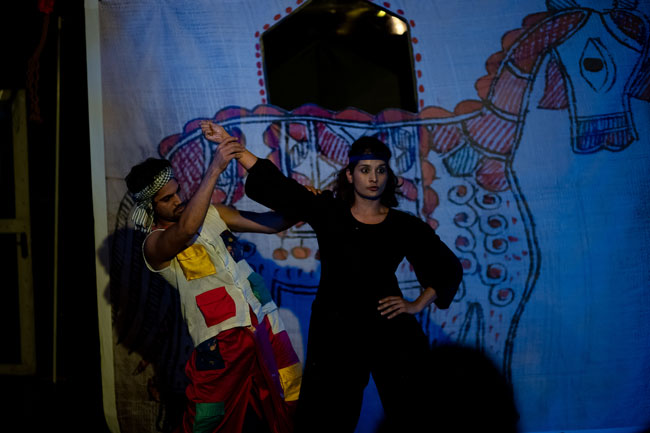William Shakespeare’s ‘Romeo and Juliet’ has inspired many cinema versions and theatre adaptations. Even today artistes are not tired of taking the plot of that love story and contemporise it. This happens all over the world. And India is no exception.
Though independent India has decades ago, and witnessed some social changes here and there, by and large the feudal mindset of Indian society has sadly remained intact. Even in the second decade of 21st century, caste-wars are reported quite frequently in which lower caste people are punished, beaten and humiliated if they carry markers of upward mobility and are often killed if they marry into ‘higher’ caste.
Sharmishta Saha, a trained theatre person, has recently started a drama group ‘Kissa Kothi’ under whose banner she has produced a play ‘Romeo Ravidas and Juliet Devi’ in Hindi. She was the resident artist at ‘Studio Tamaasha’ in February 2019, where she developed this play which is a two-hander featuring Dilip Pandey and Priyanka Charan in the eponymous parts. The play is loosely based on two real life recent incidences. In April 2018, Pradeep Rathod, a Dalit youth of Timbi village, Umrala tehsil, Gujarat was killed by villagers who belonged to upper castes. Rathod’s crime? He bought and brazenly rode a horse in the village, something a Dalit boy is not supposed to do. Dilip Pandey’s character is modelled on Pradeep Rathod.
Second incident took place in Udumalpet town, Tirupur district, Tamil Nadu. On March 13, 2016, V. Shankar was attacked ruthlessly by hired goons. The attack took place in broad-day light at a crowded place. He died in this attack. His crime? Two years ago he married Kausalya, a 19-year old girl belonging to the most backward caste of Agamudaiyar. The killers were paid by her parents, a case of honour killing. Kausalya stood firm and pursued the case, testified against her father. Today six accused including her father have been given capital punishment. Priyanka Charan’s character is modeled on Kausalya. The play has only two actors who play some minor roles.
Since the play is inspired by these two instances, some parallels with the real life story are inevitable. Romeo Ravidas, a young son of a farmer from chamar community, loves to ride his horse in his village, Dumari, Bihar. He calls his horse Juliet. In a peculiar way, he meets Kaushalya who was once known in her college as Juliet. Kaushalya belongs to Thakur community who are Kshatriyas. This Romeo-Juliet story is not a conventional love story. Romeo Ravidas and Kaushalya aka Juliet share their life stories with each other in order to be in this dream journey. Their stories tell each other the different way of life they share. Romeo’s life is nothing but deprivation and more deprivation, whereas Kaushalya’s life is nothing but a life of all possible privileges. She tells Romeo how her father got Shankar, her lover from college days, killed. This play has brilliantly used autobiographical narratives from Omprakash Valmiki’s autobiography ‘Joothan: a Dalit Life’ and Aravind Malagatti edited ‘Government Brahmana’. This is how the play moves between the fictional world and the real and the hyperreal life.
The play has been written by Sharmistha Saha and Shubham Sumit, and is directed by Saha. She has used minimalist approach while putting the play together. There is a huge backdrop of a horse on a curtain with a window. This backdrop also serves as wings where the artists disappear when not needed on the stage. The window is used to communicate with the players on the stage. Music by Aman Nath and costumes and scenography by Reema K., add value to the play.
The real credit goes to the two outstanding performances by Dilip and Priyanka who fill the auditorium with their sheer energy. Add to this the natural beauty of Bhojpuri dialect of the dialogues, and it becomes easy to understand as to why the audiences were completely riveted to their seats through this two hour performance.
Having said this, one must also mention that the play in its totality becomes a pleasant theatrical experience with pleasing music, eye-catching costumes and arresting visuals. Are these pleasant elements necessary in communicating gory experiences of caste-based atrocities? Do they not take away the seriousness of the story? But then, this decision should be best left to the director.


 [/column]
[/column]